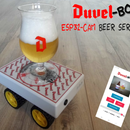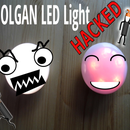Introduction: *NOT* Like a BOSS Distortion
Tired of the same old Boss-like dual-diode-clamp distortion pedals?
Want a pedal that offers truckloads of enraged guitar brutality, downright to the border of the obscene, yet is also capable of a mellow bluesy overdrive?
Want a stompbox that lets you tune what the distortion sounds like, instead of just having the choice between 'crappy' and 'even crappier' ?
Then this pedal is for you.
WARNING:Unconventional circuitry ahead
The *Not*-Like-a-Boss-Distortion pedal uses a transistor based nonlinear cell, that lets you tune the shape of the distortion.
I'll explain how to build the pedal, how the circuit works so you can impress your friends, and hey, just because you clicked and read this instructable, I'll even throw in some tips on how to customize this pedal to make it even more unique! I'll assume you have some experience with pedal/circuit building. If anything is unclear, feel free to ask.
Read on...
Step 1: The Circuit
Conventional anti-parallel diode clampers are limited in that the shape of the distortion is always the same. I've seen some pedals that try to solve this by letting you switch in several different types of diodes/leds, but it's still kinda limited. This pedal makes use of a unique nonlinear transistor circuit (Q1 and Q2), that allows you to control the shape of the distortion anywhere from shallow saturation to a hideous non-monotonic response. How so? the input stage, U1a is simple amplifier of which the DC bias and gain can be controlled, nothing special there. Observe that the nonlinear cell is symmetric around the point 'a', which is DC halfway the supply by U1b, so to understand how this works, it suffices to look at the upper half (Q1, R8, R9, R12 and R18). Suppose the wiper of R12 is completely turned to the right. Then R8, R9 and Q1 form what is known as a 'rubber zener': Q1 would then be a pretty good clamp, where it not for R18, which makes it kind of a bad clamp. Which is a good thing if you want soft distortions too. Now, if the wiper of R12 is turned completely to the left, then we get a nifty non-monotonic 'bump' like response. This means that for small voltages, the output voltage (collector of Q1) will follow the input voltage. Once the input voltage is high enough (0.6V on the base) to switch on Q1, the output will start dropping with increasing input voltage. This leads to a 'bump' response: really shreddy sounds. So the 'shape' pots allow you to tune the upper and lower distortion shapes separately, while the 'bias' setting allows you to choose where in the nonlinear function your 'zero' or resting point is. The tone and volume level control are just that: a simple low-pass tone and output level control. The oscilloscope screenshots give some idea of what is possible.
Note that the nonlinear transistor cell is not completely symmetric: R18 and R19 are unequal. This was done on purpose to give you more options.
Tip: tune R18 and R19 to your own liking, or even better: replace it with another variable resistor to have even more freedom.
Bonus Tip: replace R8 and R9 and likewise R10 and R11 with a pot, wipers going to the bases of Q1 and Q2 respectively. Obviously this won't fit in a 1590B anymore.
TL;DR: This circuit is awesome. I wish I paid better attention in 'Circuits 101'.
Step 2: Build the Circuit
The circuit can easily be soldered on a piece of perfboard. Incidentally, transistors Q1 and Q2 can be replaced with any type of small-signal transistor. Same goes for the TL072 JFET input opamp. No special component needs here.
Step 3: Build the Enclosure
The circuit is housed in the popular Hammond 1590B enclosure. I made the design for the front in Inkscape. The 'bossy' looking character is something that floats around on the internet. You can easily adjust the design (.svg) to your own needs if you are inclined to do so.
The steps to preparing the enclosure are the same as here:
https://www.instructables.com/id/Screaming-EX-Boos...
Here's how it goes:
- print the design on paper, cut out and tape to the enclosure,
- mark the positions for the holes with a sharp object and a hammer,
- drill the holes, use safety gear for ears, eyes and hands (I mean it!)
- be careful with the position of the power jack as the pots are partially underneath it,
- clean the enclosure, spray-paint it with a few layers of paint (this takes some practice),
- print the design on transparent label paper, cut out and stick on the enclosure. be sure to avoid air bubbles,
- apply a few layers of clear coating,
- stick some rubber feet to the lid.
Attachments
Step 4: Assemble the Pedal
Almost there!
Next assemble the pots, switch and connectors. Solder short (10cm, 4'') leads. I got these from a local dealer.
Be careful not to scratch the paint.
A piece of plastic from a soda bottle was cut to size and folded around the circuit board to protect it against shorts.
Place a small schematic printout in the enclosure. This will come in handy if you have to repair it some day.
That's it. Marvell at your creation!
Be sure to let me know your results if you build the NLABD.
Have fun!
EDIT: First sound sample is with gain and bias set to 12h, shape 1 to 9h, shape 2 to 3h. Second 2nd sample is with gain at max, bias 12h, shape 1 and shape 2 to max. No other processing, just guitar signal into NLAB, into PC. Excuse the lousy playing ;-)














